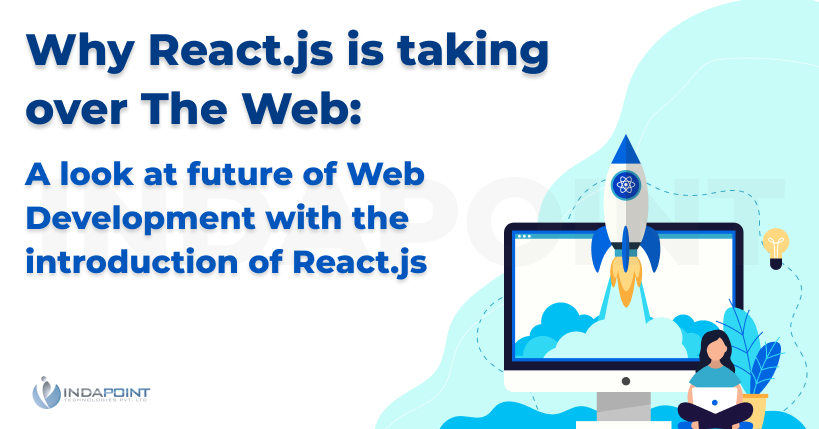Future of React
February 21, 2022

ReactJS is a declarative, flexible JavaScript framework for creating user interfaces (UI) that are more adaptable and usable. An application for various states has several advantages in terms of generating basic views and making it easier to alter and present associated components as data changes.
React.js is more than just a coming-and-going mechanism in the above group.
React.js is one of the most significant frontend libraries you may utilise in current JavaScript programming. It enables you to design highly reactive user interfaces with a rapid and mobile-app-like user experience.
As a developer, you should focus on declaratively constructing modules with React (that is, you should decide how it should look, not how it should get there), and React will take care of the rest. You can rely on its fast and efficient internal rendering process to provide an exceptional user experience.
New frameworks are being developed in web development to address the constraints of previous libraries or frameworks. Many of the flaws in previous versions, such as AngularJS, have been addressed in ReactJS. ReactJS is used to create quick and scalable web apps, and new plugins are created for it as the need for more functionality grows.
Because the technology is used in a variety of businesses, ReactJS engineers have a bright future ahead of them. React programmers are now paying the most, compared to other Web development technologies.
It will assist if you have a thorough understanding of JavaScript and even HTML5 to work with React. When dealing with JSX, you can use JS, which is comparable to JS.

Overview: Future of React
Facebook and the entire ReactJS team have demonstrated their commitment to making ReactJS more efficient. This is necessary to resolve the growing competition from other systems such as Vue.js. Any of the factors to remember in upcoming releases are server-side rendering extensions. With the current version of ReactJS, the server rendering has been updated, making it much faster and streamable. It’s an excellent place to fine-tune your presentation.
Error handling is also expected to improve, according to developers. Previously, runtime errors during rendering would leave ReactJS in an odd, broken state. This also necessitates a page refresh. Inside the part or lifecycle processes, the established model for resolving the error is thrown. Although this helps to prevent results from being corrupted, a better UX is not the best idea.
Experts in ReactJS should expect new rendering methods. To begin with, the ReactJS team is likely to add a new fragment syntax to JSX that does not require keys.

Learning “ReactJS” development makes sense since it gives developers the much-needed simplicity they need to create highly immersive mobile apps and user interfaces in a fraction of the time. They create large-scale applications that deal with constantly changing data. The benefits of being modular, scalable, agile, risk-free, and user-friendly much outweigh the difficulties that developers and businesses face.
For programmers, React is simple to use, guaranteeing that organisations can launch projects quickly and profitably. React.js is a platform that revolutionises how the frontend is handled. It will connect to an API-like backend that will access data and run backend functionality using routers, controllers, and templates.
Facebook’s creation of a framework for UI rendering was brilliant; it’s basic, easy to learn, and really useful. It will interface with an API-like backend that will access data and implement back-end functionality via routers, controllers, and models.
In this article, we’ll take a closer look at React Native’s future to give developers actual answers to the question of whether React Native is here to stay or if it will fade away like so many other JavaScript frameworks before it.
Growing popularity

Understandably, developers would rather not waste their limited time learning a technology that is likely to become obsolete shortly. However, a glance at Google Trends reveals that React Native is still a hot topic.
Many Fortune 500 organisations and startups employ React Native, including Facebook, Instagram, Bloomberg, Pinterest, Skype, Tesla, Uber, Walmart, Wix.com, and many others.
React is the framework developers say they most want to work with if they haven’t already, according to the Stack Overflow Developer Survey 2018, which polled the question and answer site’s developer community on everything from their favourite technologies to their employment preferences. As a result, it’s no surprise that React Native has piqued the curiosity of so many developers.
Efforts to empower the React Native community are in the works.

“We’re pleased to have a healthy population of React Native users and collaborators outside Facebook, in addition to the community inside Facebook,” says Sophie Alpert, Facebook’s Engineering Manager for React.
Although Facebook has always encouraged developers to engage in the development of React Native, the corporation has great plans to increase community support and empower it to define the future of the framework.
In January 2018, Facebook launched the react-native-releases repository, which allows everyone to keep track of new React Native releases more collaboratively and to discuss what should be included in each release. Facebook made a vault devoted exclusively to conversations and propositions, giving a protected climate to all individuals from the local area to create intriguing discussions connected with the primary React Native archive.
The primary contributors to React Native seek to establish a set of standards for all of the packages/repos in the project’s GitHub repository. “This new set of principles will be in place in early 2019,” says Lorenzo Sciandra, Core Maintainer and React Native Developer. “We are sure that because of these changes, the local area will turn out to be more cooperative, and that when we accomplish 1.0, we can all grow (significantly more) awesome applications because of our joined endeavours.”
Fabric is the future of React Native.
“We’re working on a big rewrite of React Native to make it more flexible and better connect with native infrastructure in hybrid JavaScript/native projects,” Alpert explains. Fabric is the codename for this ongoing project, and you can read more about it in the State of React Native report.
Conclusion
From its robust community to its momentum to the long-term goals of its main developers, everything suggests that React Native has a bright future. React Native has become a go-to framework for developers looking to create creative apps and gain a portion of the fast-rising mobile market since its initial release in 2015.
To summarise, when it comes to answering the question, what does React have in store for the future? Nobody knows is the most accurate and true response we can provide. React is incredible at what it does.
However, the rapid advancement of technology in the future will also contribute to React’s unpredictability. Who knows, maybe in three or four years we’ll have something even better.
Even with these changes, you’ll be able to adapt and turn to whatever suits you and the tech world best. What matters most,in the end, is the project you’re working on and the technologies you’re employing. As things stand, no system’s future can be predicted.






